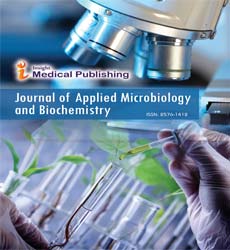ISSN : ISSN: 2576-1412
Journal of Applied Microbiology and Biochemistry
Applied Microbial Biochemistry in Combating Antimicrobial Resistance
*Corresponding author:
Eastwood Guaita
Department of Microbiology, University of Microbial Sciences, New Haven, USA
E-mail: eastwoodguaita@ier.edu
Received date: January 01, 2025, Manuscript No. ipjamb-25-20453; Editor assigned date: January 03, 2025, PreQC No. ipjamb-25-20453 (PQ); Reviewed date: January 16, 2025, QC No. ipjamb-25-20453; Revised date: January 21, 2025, Manuscript No. ipjamb-25-20453 (R); Published date: January 29, 2025, DOI: 10.36648/2576-1412.9.1.266
Citation: Guaita E (2025) Applied Microbial Biochemistry in Combating Antimicrobial Resistance. J Appl Microbiol Biochem Vol. 9 No.1: 266.
Introduction
Antimicrobial Resistance (AMR) is one of the greatest global health challenges of the 21st century, threatening to undermine decades of progress in modern medicine. The emergence and rapid spread of resistant bacteria, viruses, fungi, and parasites have rendered many frontline antibiotics and antimicrobials increasingly ineffective. This has not only complicated the treatment of infectious diseases but has also jeopardized medical procedures such as surgeries, organ transplants, and chemotherapy, which rely on effective infection control. According to the World Health Organization, AMR is projected to cause millions of deaths annually by 2050 if urgent action is not taken. In this context, applied microbial biochemistryâ??focused on understanding, manipulating, and utilizing microbial metabolic pathways, enzymatic functions, and molecular mechanismsâ??has emerged as a powerful tool in developing strategies to combat resistance. By harnessing the vast biochemical potential of microbes, researchers are uncovering new antimicrobials, designing innovative therapeutics, improving diagnostics, and engineering novel approaches to outpace the evolution of resistant pathogens [1].
Description
At its core, microbial biochemistry studies the molecular processes that govern microbial growth, survival, and adaptation. This includes an intricate network of metabolic pathways, regulatory circuits, enzymatic activities, and structural adaptations that enable microbes to thrive under diverse conditions. Importantly, many of these same pathways underlie mechanisms of antimicrobial resistance, such as drug efflux, enzymatic degradation, target modification, and biofilm formation. Applied microbial biochemistry therefore offers a dual advantage: it provides insights into resistance mechanisms that allow pathogens to evade treatment, while simultaneously enabling the discovery and engineering of biochemical solutions to restore or enhance antimicrobial efficacy. This dual perspective positions microbial biochemistry at the forefront of global strategies to counteract AMR [2].
One of the most promising areas where microbial biochemistry contributes to combating resistance is the discovery of novel antibiotics and antimicrobial compounds. Traditional soil microbiology has historically provided the majority of antibiotics in clinical use, from streptomycin to tetracyclines, yet the discovery pipeline has slowed significantly in recent decades. Advances in microbial biochemistry are reinvigorating this process by uncovering previously untapped metabolic potential within microbes. Many bacteria, particularly actinomycetes, harbor cryptic biosynthetic gene clusters that encode enzymes for secondary metabolite production. These metabolites include novel classes of antibiotics, lipopeptides, and glycopeptides with unique mechanisms of action. Through biochemical tools such as heterologous expression, pathway engineering, and metabolomics, researchers are activating these silent gene clusters and accessing natural compounds with potential to overcome existing resistance. This approach not only expands the antimicrobial arsenal but also highlights the importance of understanding microbial metabolic diversity [3].
Equally important is the role of microbial enzymes in the fight against AMR. Resistance often arises from microbial production of enzymes that inactivate antibiotics, such as β-lactamases, which hydrolyze β-lactam antibiotics. By studying the biochemistry of these enzymesâ??such as their structure, catalytic mechanisms, and substrate specificitiesâ??scientists can design enzyme inhibitors that block their activity. For example, β-lactamase inhibitors like clavulanic acid have successfully restored the clinical utility of β-lactam antibiotics. Similarly, microbial biochemistry enables the design of enzymes that degrade resistant pathogensâ?? protective barriers, such as biofilm-degrading enzymes, which sensitize microbes to antibiotics [4].
The study of microbial metabolic pathways also provides critical insights into how pathogens adapt to antimicrobial stress. Resistant microbes often rewire their metabolism to survive under drug pressure. For instance, shifts in energy production, membrane lipid composition, or amino acid biosynthesis can reduce drug susceptibility. By applying metabolomics and systems-level biochemical analyses, researchers can identify these adaptive changes and target them therapeutically [5].
Conclusion
Antimicrobial resistance poses a formidable threat to global health, but applied microbial biochemistry offers a powerful framework for developing innovative solutions. By studying and harnessing the biochemical mechanisms that underlie microbial life, scientists are uncovering novel antibiotics, designing enzyme inhibitors, engineering metabolic adjuvants, disrupting biofilms, and creating microbiome-based therapies. Furthermore, biochemical insights are enabling the development of rapid diagnostics, host-targeted therapies, and synthetic biology-based antimicrobials that bypass traditional resistance pathways. While challenges remain in translating these discoveries into practical applications, the integration of microbial biochemistry with systems biology, artificial intelligence, and nanotechnology holds immense promise. Ultimately, leveraging microbial biochemistry to combat AMR represents not only a scientific necessity but also a global imperative for safeguarding public health and ensuring a sustainable future.Acknowledgement
None.
Conflict of Interest
None.
References
- Abbenante G, Fairlie DP (2005). Protease inhibitors in the clinic. Clinic Med Chem 1: 71-104.
Google Scholar Cross Ref Indexed at
- Randolph JT, DeGoey DA (2004). Peptidomimetic inhibitors of HIV protease. Curr Top Med Chem 4: 1079-1095.
Google Scholar Cross Ref Indexed at
- Koshikawa N, Giannelli G, Cirulli V, Miyazaki K, Quaranta V (2000). Role of cell surface metalloprotease MT1-MMP in epithelial cell migration over laminin-5. J Cell Biol 148: 615.
Google Scholar Cross Ref Indexed at
- Ratnikov BI, Rozanov DV, Postnova TI, Baciu PG, Zhang H, et al. (2002). An alternative processing of integrin αv subunit in tumor cells by membrane type-1 matrix metalloproteinase. J Biol Chem 277: 7377-7385.
Google Scholar Cross Ref Indexed at
- Bartova V, Barta J, Jarosova M. (2019). Antifungal and antimicrobial proteins and peptides of potato (Solanum tuberosum) tubers and their applications. Appl Microbiol Biotechnol 103: 5533-5547.
Open Access Journals
- Aquaculture & Veterinary Science
- Chemistry & Chemical Sciences
- Clinical Sciences
- Engineering
- General Science
- Genetics & Molecular Biology
- Health Care & Nursing
- Immunology & Microbiology
- Materials Science
- Mathematics & Physics
- Medical Sciences
- Neurology & Psychiatry
- Oncology & Cancer Science
- Pharmaceutical Sciences
